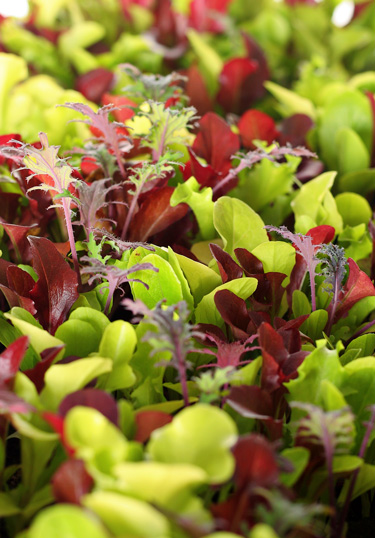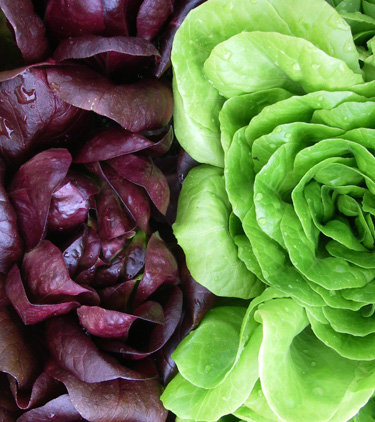Grow easy salads from seed
Leafy greens are among the healthiest foods we could eat. They are also the easiest food to grow. Because salad leaves are tastiest and most nutritious when grown fast and eaten young, they are the ideal food to grow if you don’t have a garden, or in early spring, when the soil is too soggy to dig. Simply sow some seed in the comfort of a sheltered patio and watch them grow. In a month’s time or less, you can be snipping them for dinner without even putting your gumboots on. How convenient!
Weeds, slugs and snails are also less of a problem, and your young plants will thrive with the extra warmth that comes from growing in containers. Sow fresh seed every week for a continuous supply. For extra warmth outdoors try a cloche or make a cold frame out of an old window. If growing them indoors place seedlings where there is plenty of light.
Microgreens
Herbs and vegetables eaten at the tiny seedling stage, two leaves on further from a sprout, just a week or two after germination, are know by chefs as microgreens. At this immature stage of growth they contain higher concentrations of nutrients and flavour. The leaves of almost any vege plant can be eaten as a microgreen, including fennel, spinach, celery, carrot, peas, beetroot, nasturtium, carrots and radishes. All are easily grown in seed raising trays. Sow a whole tray of one variety or a mixture of different greens. Some seeds come ready-mixed, such as Yates Mesclun French salad mix.
Container options
Provided there is sufficient soil space to hold the all-important water and nutrients, plus holes for drainage, any container will do. Small pots (especially porous terracotta) are not ideal because they tend to dry out too easily, but you don’t need excessively deep containers. A depth of 30cm allows plenty of root space.
Garden centres stock a range of attractive pots made from UV resistant plastic. Smart looking and built to last, Yates ‘Tuscan Edge’ pots and troughs are ideal for salad greens and herbs. They come with a clever inbuilt watering system that does away with grubby saucers.
The portable Tui Haxnicks Patio & Balcony Raised Bed is designed especially for growing salads and herbs in small or temporary spaces, made from tough polyethylene so it will last many growing seasons.
Other options include old recycling bins, plastic fish bins with holes drilled for drainage, timber planter boxes, large planter bags, or woven polypropylene stock feed sacks with their tops rolled down.
Salad Selection
Get the best choice of salad greens by growing your own from seed. The more variety, the more interesting your salads will be. Include a few edible flowers for colour.
- Loose leaf lettuces - e.g. Lollo Rosso and Oak Leaf (red and green). Pick the outer leaves allowing the plant to carry on growing. A variety of colours and textures makes a decorative mix.
- Cos (Romaine) lettuces - Crunch, taste and vitamins too, with some interesting coloured and speckled varieties available as seed.
- Butterhead lettuces – e.g. ‘Buttercrunch’ and ‘Tom Thumb’. Tidy rosettes look great in the garden. The leaves are soft to bite and vitamin-rich.
- Spinach - Top for nutrients and best eaten young as a salad.
- Beets - Baby beetroot leaves add colour and flavour. Plus they’re highly nutritious. Raw silverbeet is also tasty when eaten young.
- Endive - A Mediterranean salad herb that’s slower growing but more tolerant of summer heat than other greens.
- Miner’s Lettuce - Delicate heart shaped leaves rich in vitamin C, named after the California gold rush miners who ate it to fight scurvy. Unlike other herbs it does not grow bitter as it ages, but retains its delicate spinach flavour. Best in spring, it makes a pretty groundcover with pink or white flowers. Self sows.
- Rocket adds a spicy tang to salad or sandwich. Best grown in spring and autumn. Very fast and easy from seed sown direct into garden soil.
- Sorrel - Tangy lemony leaves best grown fast and eaten young. Like rocket it is best grown in spring or autumn, or part shade to avoid summer heat. Cut low for salads and it will grow back again. Easily grown from seed.
- Cress - Nutritious peppery garden cress is extremely quick and easy to grow in ordinary soil and can be cut for eating from just ten days old. Easy to grow in containers by a sunny window.
- Mustard - Another quick and easy green with a zesty tang. Best eaten very young.
- Mizuna - Easy to grow and a pretty texture in the garden but little flavour. Use it to tart up a mesclun mix.
- Radicchio - An excellent cool season crop with colourful red leaves, good crunch and great taste.
- Snow peas - No need to wait for the peas, the seedlings also have that sweet crunchy taste.
- Basil - Choose purple basil for extra colour.
- Nasturtium - Both flowers and leaves are edible.
- More salad herbs - Fennel, mint, chervil, coriander, Italian parsley.
- Edible flowers – Calendula, pea flowers, viola, nasturtium, chives, borage. Great to have on hand for colour, flowers add extra nutrients too. Separate composite flowers, such as calendula and chives, into petals before use.
Patio salads from seed
Step by step
- Fill your container. Seed raising mix ensures optimum germination, but a good potting mix (or ‘vegetable growing mix’) contains the nutrients needed for continuous healthy growth. Ideally, for salad greens you want to grow past the micro-green stage, use a mix that contains fertiliser, topped with a 10-20mm layer of seed raising mix.
- Create a level surface and press the mix down firmly using a small block of wood.
- Water the mix to moisten thoroughly, then leave it to drain for a few minutes.
- Sprinkle fresh seeds over the top of the seed raising mix.
- Lightly cover seeds with a very fine layer of mix. Check the instructions on the seed packet. Fine seeds barely need covering, while larger seeds, like snow peas need to be pushed into the mix.
- Place the tray in a warm, sheltered spot.
- Water using a fine mist spray bottle whenever the soil starts to look a little dry, keeping the mix moist but not wet.
- Once seedlings are past the first leaf (‘micro-green’) stage, feed once a week with liquid fertiliser, especially if growing in seed raising mix.
Better lettuce
- The faster your lettuces grow, the better they’ll taste. Slow or erratic growth from lack of water, warmth or food results in bitter leaves.
- Salad greens thrive with lots of nitrogen but need other nutrients too. For lettuces in pots, combine slow release fertiliser with liquid fertiliser or worm tea from your worm farm.
- Harvesting of young outer lettuce leaves encourages new growth in loose-leaf varieties.
- For the best nutrition and flavour pick leaves fresh for each meal rather than storing them in the fridge.
- The greener the leaf, the more vitamins and minerals it will contain.
19-Oct-2014

Microgreens

Red and green lettuce


